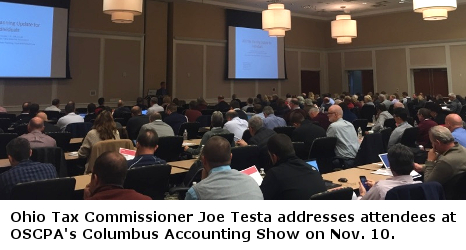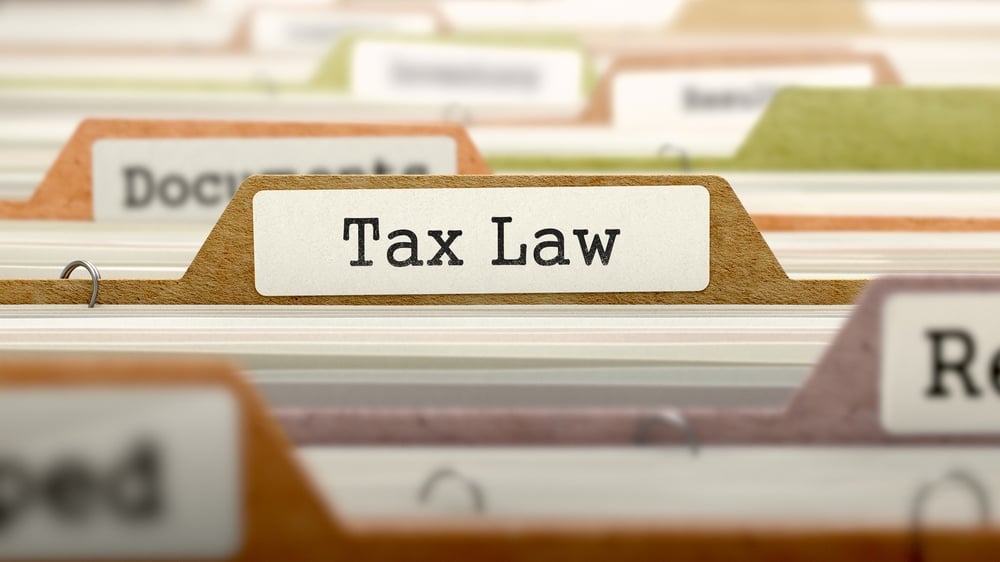Ohio Tax Commissioner Joe Testa has announced that effective January 1, 2019, there will be changes to the state’s income tax withholding tables. These changes will be the first to the state’s withholding amounts since 2015.
Tax planning – Why is this year any different?
Zinner & Co. Tax Team Taxes - Corporate & Business , Taxes - Individual , deductions , income tax , Tax Cuts and Jobs Act of 2017Every year at this time, you start to hear more about the importance of year-end income tax planning in radio and television commentary. For many people with more complex businesses or investments, the beginning of the 4th quarter of the year signals the time to start to organize their tax documents and to set-up an appointment with their advisors to review results.
This year is different! This year, tax planning should be important to everyone, not just for those that have complex tax situations. The implementation of the Tax Cuts and Jobs Act of 2017 has impacted every taxpayer. While we have all heard about it, not everyone has an applied working knowledge of what the impact will be in the first annual income tax filing season, which begins in about three months.
Updated Withholding Calculator, Form W-4 Released; Calculator Helps Taxpayers Review Withholding Following New Tax Law
Zinner & Co. Tax Department withholding , Brett W. Neate , Taxes - Individual , income taxWASHINGTON –The Internal Revenue Service recently released (2/28/18 irs.gov) an updated Withholding Calculator on IRS.gov and a new version of Form W-4 to help taxpayers check their 2018 tax withholding following passage of the Tax Cuts and Jobs Act in December.
The IRS urges taxpayers to use these tools to make sure they have the right amount of tax taken out of their paychecks.
“Following the major changes in the tax law, the IRS encourages employees to check their paychecks to help ensure they’re having the right amount of tax withheld for their personal situation,” said Acting IRS Commissioner David Kautter.
The Ohio Department of Taxation is offering amnesty from Jan. 1 to Feb. 15, 2018 to individual and business taxpayers.
ODT has launched a statewide campaign to raise awareness of the amnesty. Ohio Tax Commissioner Joe Testa kicked off the effort Nov. 10 by discussing the issue with attendees at OSCPA’s Columbus Accounting Show.
The Department of Taxation will offer amnesty on the following:
- Individual taxes
- School district income taxes
- Employer withholding taxes
- Employer withholding for school district income taxes
- Pass-through entity taxes sales tax
- Use taxes
- Commercial activity
- Financial institutions
- Cigarette and other tobacco products
- Alcoholic beverage
Amnesty is available only for taxes that were due and payable as of May 1, 2017, and still remain underreported or unreported. Those who fully pay qualifying tax delinquencies will owe no penalties and only half the interest normally charged. The program does not apply to any tax for which a notice of assessment or audit has been issued, for which a bill has been issued, that relates to a still-open tax period, or for which an audit has been conducted or is pending.
Taxpayers can learn more and determine eligibility at www.OhioTaxAmnesty.gov; or by calling 800-304-3211.
This article appears courtesy of the Ohio Society of CPAs Community News published Nov. 16, 2017.
Tis the Season of Saving: 5 things you can do now to help reduce your taxes
Zinner & Co. Taxes - Corporate & Business , Taxes - Individual , income tax , Matt SzydlowskiIn the quest for gifts and seasonal savings together with the promise of continued prosperity, many taxpayers overlook some of the simple year-end moves they can do that will help to reduce their taxes and improve the bottom line. There are many action steps you can perform today in order to save taxes for the next tax period. Below, find a shining display of our top five tips to save future tax dollars.
Today is the Day the New I-9 Form Must be Put to Use by Employers
Zinner & Co. Tax Department income taxThe I-9 Form updated 7/17/17 must be used for all new hires starting today, 9/18/17. The form can be found on the U.S. Citizenship and Immigration Services' (USCIS) website at https://www.uscis.gov/sites/default/files/files/form/i-9.pdf.
Related read: What to know if you are planning to hire in the coming weeks
IRS Warns of New Phone Scam Involving Bogus Certified Letters; Reminds People to Remain Vigilant Against Scams, Schemes this Summer
Zinner & Co. Tax Team fraud , income tax , IRSPay Me Now, Pay Me Later: Should you pay quarterly estimates or utilize tax withholdings?
Zinner & Co. Taxes - Individual , income tax , IRS , Matt SzydlowskiMany clients ask if it is more advantageous to pay quarterly tax estimates or utilize their tax withholding. I wish there were a simple, cookie-cutter answer. However, as no two taxpayers are alike, the same goes for the manner in which one can pay one’s taxes.
Both methods of paying income tax have their pros and cons. The best selection depends on your personal preference and, more so, financial situation. A majority of self-employed individuals must utilize quarterly payments. However, if you have an income source such as retirement distributions, social security or employee wages, you have the option of withholding tax from those income streams in lieu of paying quarterly.
I Just Received a Huge Tax Refund! Why this may not be a good thing to brag about…
Zinner & Co. Tax Department Taxes - Individual , income tax , IRSI pay all the taxes owed, and not a penny more” – Mitt Romney
For many taxpayers, the dread of gathering information, preparing a tax return, and filing it is tedious and time consuming. However, just as the sun shines brightest after a rain, cheers and smiles replace the angst of prep when the tax refund check makes its way to the bank account.
“I’m going to … take a trip, buy a TV, go shopping…” After all, a common thought when receiving the refund is “it’s my money AND it is a refund! I should live a little.”
Need More Time to Pay Your Taxes?
Zinner & Co. Tax Department Brett W. Neate , Taxes - Individual , income taxFrom the IRS newsroom:
All taxpayers should file on time, even if they can’t pay what they owe. This saves them from potentially paying a failure to file penalty. Taxes are due by the original due date of the return.
Here are four tips for those who can’t pay their taxes in full by the April 18 due date:
About Us

Since 1938, Zinner has counseled individuals and businesses from start-up to succession. At Zinner, we strive to ensure we understand your business and recognize threats that could impact your financial situation.
Recent Blog Posts
Categories
- 1031 Exchange (2)
- 401k (2)
- 529 plan (4)
- ABLE Act (1)
- account systems (3)
- accounting (8)
- Affordable Care Act (8)
- alimony (2)
- American Rescue Plan Act (1)
- Ask the Expert (5)
- Audit and Assurance Department (13)
- audits (8)
- Bank Secrecy Act (1)
- banks (1)
- Barbara Theofilos (6)
- Beneficial Ownership Information (1)
- Bitcoin (1)
- block chain (2)
- BOI (3)
- Bookkeeping (1)
- Brett W. Neate (28)
- budgets (1)
- Bureau of Worker's Compensation (12)
- Business - Management, Issues & Concerns (51)
- business income deduction (3)
- business succession (7)
- business travel expense (3)
- business valuation (5)
- capital gains (2)
- careers (7)
- cash flow (2)
- Charitable Donations (1)
- Child Tax Credit (2)
- Chris Valponi (8)
- City of Cleveland (1)
- Cleveland COVID-19 Rapid Response Fund (1)
- Cleveland Rape Crisis Center (2)
- college (3)
- Community (24)
- Compliance (1)
- Coronavirus (24)
- Corporate Transparency Act (1)
- COVID-19 (30)
- Credit card fraud (5)
- credit reporting (2)
- cryptocurrency (2)
- CTA (2)
- cybersecurity (17)
- dead (1)
- DeAnna Alger (6)
- death (2)
- debt (4)
- deductions (14)
- Deferring Tax Payments (4)
- Department of Job and Family Services (2)
- depreciation (2)
- Digital Tax Payment (3)
- divorce (4)
- DOMA (3)
- Economic Impact Payments (2)
- Economic Injury Disaster Loan (4)
- education (8)
- EIDL (1)
- electronic filing (4)
- Electronic Tax Payments (3)
- Emergency Working Capital Program (1)
- employee benefit plan auditor (1)
- Employee Leave (3)
- Employee or Independent Contractor (6)
- Employee Retention Credit (3)
- employment (2)
- ERC (3)
- Eric James (8)
- Estates, Gifts & Trusts (48)
- expenses (5)
- Families First Coronavirus Response Act (2)
- FASB (1)
- FBAR (1)
- FDIC coverage (1)
- Federal Assistance (4)
- filing (3)
- financial planning (8)
- Financial Planning - College (9)
- financing (3)
- Firm news (119)
- first responders (1)
- FMLA (1)
- foreign assets (3)
- fraud (38)
- FSA (1)
- fundraising (9)
- Gabe Adler (1)
- gift tax (5)
- HDHP (2)
- health care (3)
- home (2)
- home office (1)
- Howard Kass (2)
- HRA (1)
- HSA (5)
- identity theft (34)
- income (1)
- income tax (58)
- independent contractor (1)
- Inflation (1)
- Insurance (7)
- internal control (4)
- international (2)
- Intuit (1)
- investments (4)
- IRS (91)
- jobs (5)
- John Husted (1)
- K-1 (1)
- Laura Haines (3)
- Layoff (2)
- Layoffs (1)
- leadership (3)
- lease accounting standards (1)
- life insurance (1)
- LLC (3)
- Loans (2)
- longevity income annuities (1)
- Lorenzo's Dog Training (1)
- Magic of Lights (1)
- management advisory (3)
- manufacturing (2)
- Matt Szydlowski (3)
- medical (7)
- Medicare (2)
- mergers and acquisitions (1)
- Mike DeWine (2)
- Millennial Concepts (2)
- minimum wage (1)
- NAIOP (1)
- National Defense Act (1)
- non-profit reporting (10)
- non-profits (38)
- not-for-profit (26)
- OATC (1)
- OBBB (3)
- ODJFS (1)
- office (1)
- ohio (13)
- Ohio Accounting Talent Coalition (1)
- Ohio business owners (18)
- Ohio Department of Jobs and Family Services (4)
- Ohio Department of Taxation (7)
- Ohio Incumbent Workforce Training Voucher Program (1)
- Ohio Society of Certified Public Accountants (1)
- One Big Beautiful Bill (7)
- Online Tax Payment (4)
- Operations (2)
- OPERS (1)
- OSCPA (1)
- owners of foreign entities (1)
- partnerships (5)
- passwords (1)
- Paycheck Protection Program (9)
- payroll (8)
- penalties (3)
- pension (2)
- personal finance (2)
- planning (4)
- ppp (7)
- Productivity (5)
- Qualified Business Income (1)
- quickbooks (10)
- real estate (14)
- record retention (2)
- records (2)
- Reporting (1)
- Republican National Convention (1)
- Retirement Planning & IRAs (54)
- Richard Huszai, CPA (5)
- RITA (1)
- Robin Baum (6)
- RRF (1)
- S Corporation (1)
- SALT (8)
- SBA (8)
- scams (14)
- SECURE 2.0 Act (1)
- security (6)
- SharedWorks (1)
- Shutdown (3)
- Silver Linings (9)
- simplified employee pension (1)
- Small Business (5)
- SMB (12)
- Social Media (1)
- social security (4)
- Speaker Series (2)
- spouse (1)
- start ups (8)
- Stay at Home Order (3)
- Steven Mnuchin (1)
- Sue Krantz (6)
- SVOG (1)
- tangible property (1)
- tax (27)
- tax avoidance (12)
- Tax Credit (7)
- Tax Cuts and Jobs Act of 2017 (31)
- Tax Exempt (1)
- Tax Holiday (1)
- Tax Interns (2)
- tax services (28)
- taxes (45)
- Taxes - Corporate & Business (106)
- Taxes - Individual (122)
- Taxes - Planning, Rules and Returns (195)
- TechCred (1)
- technology (8)
- The CARES Act (6)
- The SOURCE (1)
- tiag (3)
- transaction advisory (2)
- Treasury Department (5)
- Trump Account (1)
- tuition (3)
- U.S. Department of the Treasury (1)
- U.S. Small Business Administration (6)
- Unclaimed Funds (1)
- Unemployment Benefits (4)
- Unemployment Insurance (1)
- withdrawls (2)
- withholding (6)
- Workers Comp Billing Changes (1)
- Zinner & Co. (35)
- Zinner News (32)











